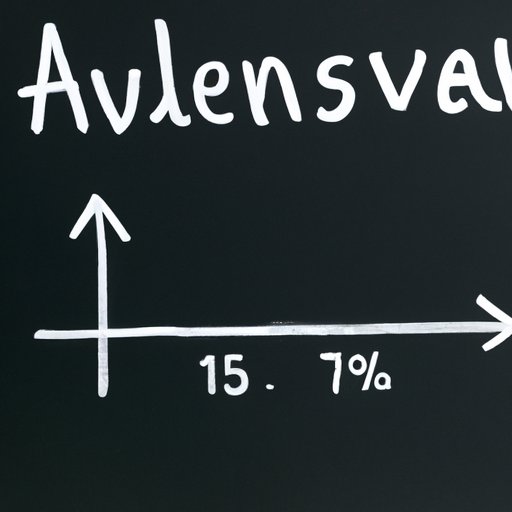
Introduction
Data analysis is an essential aspect of various fields, including business, finance, and healthcare. One of the most important measures in data analysis is variability, which helps identify the spread of data from the central tendency. Mean Absolute Deviation (MAD) is a vital measure of variability that can help in understanding the spread of the data points. This article is a comprehensive guide for data analysts who want to learn how to find MAD and apply it to real-life scenarios.
What is Mean Absolute Deviation?
Before diving into the calculations, it’s important to understand what MAD is and its importance in data analysis. MAD calculates the average distance between each data point and the mean. It gives an idea of how dispersed the data is and how far each data point is from the central tendency. Unlike other measures of variability, such as variance and standard deviation, MAD uses absolute values, which removes the negative sign. It is useful in situations where the data is not normally distributed or contains outliers.
For instance, imagine there are ten students in a class, and their grades are as follows: 80, 75, 85, 90, 68, 95, 89, 72, 88, and 78. The mean of these grades is 82. The MAD will tell us how far each student’s grade is from the mean. This information can be useful in identifying which students need extra help or who are performing exceptionally well.
Calculating Mean Absolute Deviation
Now that we understand what MAD is let’s dive into the calculations. The formula for MAD is simple, as seen below.
Where,
xᵢ = the i-th value in the data set
x̄ = the mean of the data set
n = the number of items in a data set
The absolute function, represented by the vertical bars, ensures that negative values do not skew the results. When calculating MAD, the absolute difference is taken between each data point and the mean. The absolute differences are then summed and divided by the number of data points.
Let’s take the example of the student’s grades. We’ve already calculated the mean of the grades. Below is the step-by-step guide for calculating MAD.
1. Calculate the absolute value of each deviation from the mean. For instance, |80-82|=2 represents the difference between the first student’s grade (80) and the mean (82).
2. Calculate the sum of the absolute deviations. In this case, the sum is 169.
3. Divide the sum of absolute deviations by the number of data points to get MAD.
Therefore, the MAD for the student’s grades is 16.9.
Real-life Examples
Calculating MAD can be helpful in various real-life scenarios. One scenario is predicting sales trends based on previous sales data. Imagine a retail store that wants to predict the number of units that would sell for a particular item next month. The store can use the MAD of the earlier sales to forecast the number of sales.
In another scenario, MAD could be useful in tracking changes in stock prices. Stocks that have a low MAD are considered less risky compared to those with high MAD. Additionally, companies can also use MAD when calculating the projected value of future earnings. MAD becomes particularly useful in these cases as it is not influenced by extreme values or outliers.
Methods for Calculating MAD
Although the formula may seem straightforward, there are different methods for calculating MAD. These include using the absolute value function, which is the standard method, or the “shortcut” formula. The “shortcut” formula involves squaring each deviation from the mean and calculating the square root of the mean of the squares. Below are the two methods:
1. Using the absolute value function:
2. Using the “shortcut” formula:
The advantage of using the absolute value function is that it is easier to understand and apply. The “shortcut” method can be faster, but it involves squaring and rooting values, which can be a challenge for some individuals.
Case Study
Let’s explore a case study that demonstrates the use of MAD. In the financial industry, MAD can be helpful in identifying trends in stock prices. Stocks that have a low MAD are seen as less volatile and thus less risky compared to those with high MAD. For instance, let’s say there’s a stock market that has an average return of 10% over the past five years. If its MAD is 5%, it means that most of the returns were within the range of 5% and 15%, indicating that the stock is a reliable one. However, if the MAD is 15%, it means that the returns were more volatile and outside the safe range, indicating that the stock is risky.
Common Challenges and Misconceptions
When calculating MAD, some common challenges and misconceptions may arise. One challenge is dealing with negative numbers. To overcome this, we use the absolute value of the deviation from the mean. Another challenge is calculating the mean itself. If there are large outliers present, using the median would be a better option. It’s worth noting that MAD and standard deviation are interchangeable if the data is normally distributed.
Conclusion
Mean Absolute Deviation is a vital measure of variability that can provide valuable insights into data sets. Calculating MAD might seem overwhelming at first, but it is a relatively straightforward calculation. In real-life situations, MAD can be used for predicting sales trends or projecting changes in stock prices. Understanding MAD and its various methods of calculation can be helpful for anyone looking to analyze data and make predictions.




